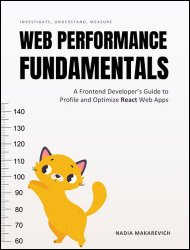 Название: Web Performance Fundamentals: A Frontend Developer’s Guide to Profile and Optimize React Web Apps
Название: Web Performance Fundamentals: A Frontend Developer’s Guide to Profile and Optimize React Web AppsАвтор: Nadia Makarevich
Издательство: getwebperf.com
Год: 2025
Страниц: 386
Язык: английский
Формат: epub
Размер: 54.1 MB
Get the practical tools and techniques you need to make your React apps faster, smoother, and more efficient.
The book is about the fundamentals of web performance that are particularly relevant for React developers. This is not a book about how to write React code. There are plenty of books for that already. It's almost the opposite - it's about everything that is not React code. Everything that surrounds it and contributes to what we know as Performance.
In this book, you won't learn different state management techniques or how to split components. However, you will learn on a very deep level how to record and understand Performance Flame Graphs, different types of server and client rendering, how different data fetching strategies contribute to initial load performance, and so much more.
In the next chapter, "Let's Talk About Performance", we'll look into why bother with performance in the first place, other than for personal entertainment. Plus, what the CrUX report is, why it's useful, and a few other resources to get you started with measuring performance.
In "Intro to Initial Load Performance," we'll take a first look at the Chrome DevTools Performance and Lighthouse panels, understand what Initial Load is and how to measure it via metrics like FCP and LCP, and make our first few discoveries. While doing so, we'll investigate how different network conditions influence initial load, what a CDN is for, and learn the basics of Cache Control.
In the "Client-Side Rendering and Flame Graphs" chapter, we'll become proficient in recording and understanding the Performance Flame Graphs - you know, those colorful monstrosities that confuse everyone who sees them for the first (or tenth) time. While doing so, we'll understand what the Client-Side Rendering (CSR) pattern is and why it's important.
In the "SPAs and Introducing INP" chapter, we'll continue with CSR and its natural extension, the Single-Page Application (SPA). While doing so, we'll learn more about DevTools, touch on the next performance metric, INP, and look more into the Lighthouse report.
In the "Intro to Rendering on the Server (SSR)", we'll investigate, you've guessed it, Server-Side Rendering. We'll implement our own pre-rendering strategy, understand the cost of introducing SSR to a previously CSR app, how SSR affects initial load metrics, what hydration is, and how to implement SSR properly in React code.
The "Bundle Size and What to Do About It" chapter focuses on the size of jаvascript we're producing and why it matters (or doesn't matter). In the process of this investigation, you'll learn about compression, which aspects of initial load the size of jаvascript can affect, become a master of bundle size analysis, touch on the difference between HTTP/1 and HTTP/2 & 3, learn about preloading, code splitting, tree shaking, different module formats, transitive dependencies, and probably more. It's a huge chapter!
Who This Book Is For:
The primary target audience for this book is middle-to-senior React developers who want to deepen their knowledge and are interested in learning about web performance. This book assumes that you've written an app or two already and that I don't need to explain such concepts as "state", "props", "components", or "conditional rendering". If you're a seasoned frontend developer but completely new to React, you also might gain a lot. About two-thirds of the book focuses on fundamental knowledge applicable to any web app. However, be warned: all the code examples and the Study Project are written in React, so you'll need to be able to navigate through them effectively. A few chapters focus on React-specific APIs like Server Components or Suspense. And a few chapters, even though the concept is universal, cover aspects specific to React apps. Such as Server-Side Rendering (SSR) and how to implement it properly in React.
Contents:
About the author:
Скачать Web Performance Fundamentals: A Frontend Developer’s Guide to Profile and Optimize React Web Apps
